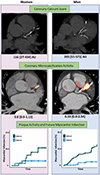Sex differences in coronary atherosclerotic plaque activity using 18F-sodium fluoride positron emission tomography
- PMID: 38926161
- PMCID: PMC11774508
- DOI: 10.1007/s00259-024-06810-x
Sex differences in coronary atherosclerotic plaque activity using 18F-sodium fluoride positron emission tomography
Abstract
Introduction: There are sex differences in the extent, severity, and outcomes of coronary artery disease. We aimed to assess the influence of sex on coronary atherosclerotic plaque activity measured using coronary 18F-sodium fluoride (18F-NaF) positron emission tomography (PET), and to determine whether 18F-NaF PET has prognostic value in both women and men.
Methods: In a post-hoc analysis of observational cohort studies of patients with coronary atherosclerosis who had undergone 18F-NaF PET CT angiography, we compared the coronary microcalcification activity (CMA) in women and men.
Results: Baseline 18F-NaF PET CT angiography was available in 999 participants (151 (15%) women) with 4282 patient-years of follow-up. Compared to men, women had lower coronary calcium scores (116 [interquartile range, 27-434] versus 205 [51-571] Agatston units; p = 0.002) and CMA values (0.0 [0.0-1.12] versus 0.53 [0.0-2.54], p = 0.01). Following matching for plaque burden by coronary calcium scores and clinical comorbidities, there was no sex-related difference in CMA values (0.0 [0.0-1.12] versus 0.0 [0.0-1.23], p = 0.21) and similar proportions of women and men had no 18F-NaF uptake (53.0% (n = 80) and 48.3% (n = 73); p = 0.42), or CMA values > 1.56 (21.8% (n = 33) and 21.8% (n = 33); p = 1.00). Over a median follow-up of 4.5 [4.0-6.0] years, myocardial infarction occurred in 6.6% of women (n = 10) and 7.8% of men (n = 66). Coronary microcalcification activity greater than 0 was associated with a similarly increased risk of myocardial infarction in both women (HR: 3.83; 95% CI:1.10-18.49; p = 0.04) and men (HR: 5.29; 95% CI:2.28-12.28; p < 0.001).
Conclusion: Although men present with more coronary atherosclerotic plaque than women, increased plaque activity is a strong predictor of future myocardial infarction regardless of sex.
Keywords: 18F-NaF PET; Coronary artery disease; Gender; Myocardial infarction; Sex.
© 2024. The Author(s), under exclusive licence to Springer-Verlag GmbH Germany, part of Springer Nature.
Conflict of interest statement
Compliance with Ethical Standards
The authors have no relevant financial or non-financial interests to disclose.
The studies were conducted with the approval of the Scottish Research Ethics Committee (14/SS/0089, 15/SS/0203 and 15-SS-0059), in accordance with the Declaration of Helsinki, and with the written informed consent of each participant.
Figures




References
-
- Irkle A, Vesey AT, Lewis DY, Skepper JN, Bird JL, Dweck MR, Joshi FR, Gallagher FA, Warburton EA, Bennett MR, Brindle KM, Newby DE, Rudd JH, Davenport AP. Identifying active vascular microcalcification by (18)F-sodium fluoride positron emission tomography. Nat Commun. 2015. Jul 7;6:7495. doi: 10.1038/ncomms8495. - DOI - PMC - PubMed
-
- McKenney-Drake ML, Territo PR, Salavati A, Houshmand S, Persohn S, Liang Y, Alloosh M, Moe SM, Weaver CM, Alavi A et al. 18F-NaF PET imaging of early coronary artery calcification. J. Am. Coll. Cardiol 2016, 9, 627–628. - PubMed
-
- Bellinge JW, Francis RJ, Lee SC et al. 18F-Sodium Fluoride Positron Emission Tomography Activity Predicts the Development of New Coronary Artery Calcifications. Arterioscler Thromb Vasc Biol. 2021. Jan;41(1):534–541 - PubMed
MeSH terms
Substances
Grants and funding
LinkOut - more resources
Full Text Sources
Medical

